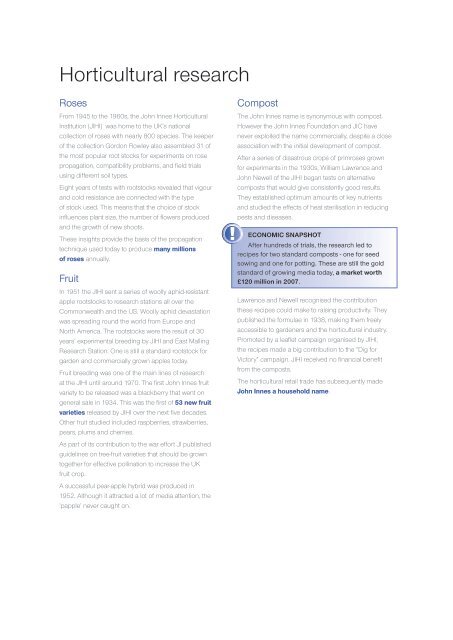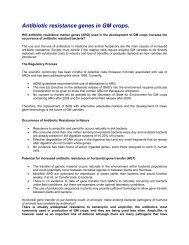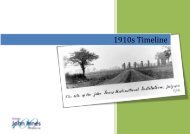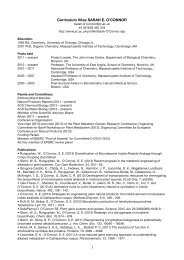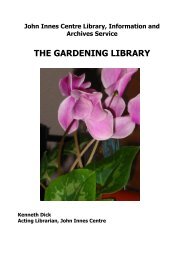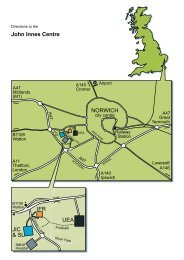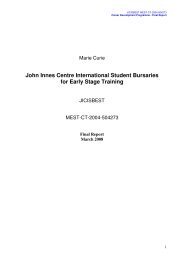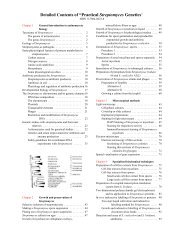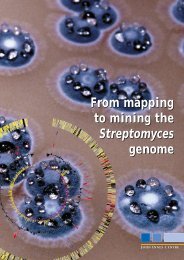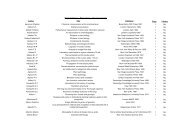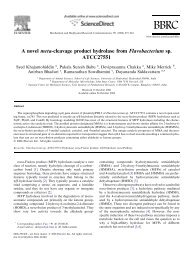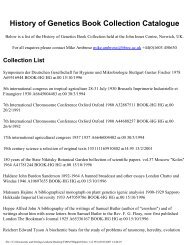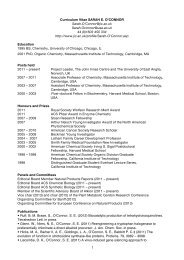Economic Impact brochure - John Innes Centre
Economic Impact brochure - John Innes Centre
Economic Impact brochure - John Innes Centre
You also want an ePaper? Increase the reach of your titles
YUMPU automatically turns print PDFs into web optimized ePapers that Google loves.
Horticultural research<br />
Roses<br />
From 1945 to the 1960s, the <strong>John</strong> <strong>Innes</strong> Horticultural<br />
Institution (JIHI) was home to the UK’s national<br />
collection of roses with nearly 800 species. The keeper<br />
of the collection Gordon Rowley also assembled 31 of<br />
the most popular root stocks for experiments on rose<br />
propagation, compatibility problems, and field trials<br />
using different soil types.<br />
Eight years of tests with rootstocks revealed that vigour<br />
and cold resistance are connected with the type<br />
of stock used. This means that the choice of stock<br />
influences plant size, the number of flowers produced<br />
and the growth of new shoots.<br />
These insights provide the basis of the propagation<br />
technique used today to produce many millions<br />
of roses annually.<br />
Fruit<br />
In 1951 the JIHI sent a series of woolly aphid-resistant<br />
apple rootstocks to research stations all over the<br />
Commonwealth and the US. Woolly aphid devastation<br />
was spreading round the world from Europe and<br />
North America. The rootstocks were the result of 30<br />
years’ experimental breeding by JIHI and East Malling<br />
Research Station. One is still a standard rootstock for<br />
garden and commercially grown apples today.<br />
Fruit breeding was one of the main lines of research<br />
at the JIHI until around 1970. The first <strong>John</strong> <strong>Innes</strong> fruit<br />
variety to be released was a blackberry that went on<br />
general sale in 1934. This was the first of 53 new fruit<br />
varieties released by JIHI over the next five decades.<br />
Other fruit studied included raspberries, strawberries,<br />
pears, plums and cherries.<br />
As part of its contribution to the war effort JI published<br />
guidelines on tree-fruit varieties that should be grown<br />
together for effective pollination to increase the UK<br />
fruit crop.<br />
A successful pear-apple hybrid was produced in<br />
1952. Although it attracted a lot of media attention, the<br />
‘papple’ never caught on.<br />
!<br />
Compost<br />
The <strong>John</strong> <strong>Innes</strong> name is synonymous with compost.<br />
However the <strong>John</strong> <strong>Innes</strong> Foundation and JIC have<br />
never exploited the name commercially, despite a close<br />
association with the initial development of compost.<br />
After a series of disastrous crops of primroses grown<br />
for experiments in the 1930s, William Lawrence and<br />
<strong>John</strong> Newell of the JIHI began tests on alternative<br />
composts that would give consistently good results.<br />
They established optimum amounts of key nutrients<br />
and studied the effects of heat sterilisation in reducing<br />
pests and diseases.<br />
ECONOMIC SNAPSHOT<br />
After hundreds of trials, the research led to<br />
recipes for two standard composts - one for seed<br />
sowing and one for potting. These are still the gold<br />
standard of growing media today, a market worth<br />
£120 million in 2007.<br />
Lawrence and Newell recognised the contribution<br />
these recipes could make to raising productivity. They<br />
published the formulae in 1938, making them freely<br />
accessible to gardeners and the horticultural industry.<br />
Promoted by a leaflet campaign organised by JIHI,<br />
the recipes made a big contribution to the “Dig for<br />
Victory” campaign. JIHI received no financial benefit<br />
from the composts.<br />
The horticultural retail trade has subsequently made<br />
<strong>John</strong> <strong>Innes</strong> a household name.


